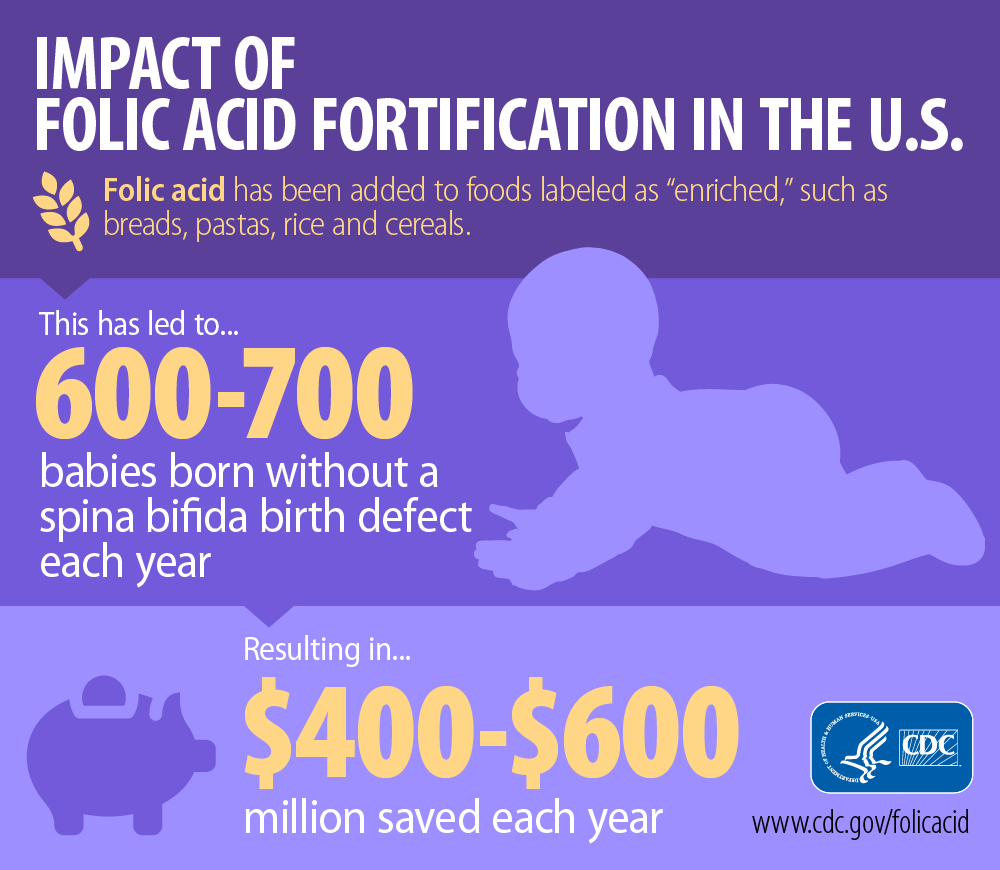Key Findings: Cost savings of spina bifida prevention after folic acid fortification in the United States
The American Journal of Preventive Medicine published a new study looking at the costs associated with a United States requirement that folic acid (a B vitamin) be added to all cereal grain products labeled as enriched (also called folic acid fortification). In this study, CDC researchers found that after folic acid fortification, an estimated 600-700 babies are born each year without spina bifida (a severe birth defect of the spine), who would have otherwise been affected were it not for fortification. They also estimated that the amount of money saved as a result of the fortification policy (also called cost savings) is around $400 million to $600 million dollars every year in the United States. These estimates can be useful to decision makers in other countries who are considering folic acid fortification. To learn more, read a summary of the key findings below or read the abstract of the article.
About this Study
This study looked at potential cost savings associated with spina bifida prevention after folic acid fortification of enriched cereal grains in the United States. Using U.S. birth defects tracking systems data, CDC researchers compared the number of babies born with spina bifida before folic acid fortification (1995-1996) to the number of babies born with spina bifida after folic acid fortification (1999-2011).
Health economics researchers participating in this study then estimated the following:
- The costs of health care, special education and developmental services for children who would have been affected by spina bifida;
- The decrease in parents’ paid work related to caring for a child with spina bifida; and
- The cost of folic acid fortification.
Researchers used these costs to calculate the lowest possible and average estimates for total cost savings in the United States after folic acid fortification was implemented.
Main Findings
- After folic acid fortification in the United States, an estimated 600-700 babies are born each year without spina bifida, who would have otherwise been affected were it not for fortification.
- Mandatory folic acid fortification of enriched cereal grain products in the United States saves an estimated $400 million to $600 million dollars every year.

Remember!
CDC urges all women who are capable of becoming pregnant to get at least 400 micrograms (mcg) of folic acid every day. It is especially important for women to get this amount of folic acid at least one month before becoming pregnant to help prevent spina bifida and other neural tube defects (serious birth defects of the brain and spine). Women can get folic acid in these ways:
- Take a vitamin containing 400 mcg of folic acid every day.
- Eat a bowl of breakfast cereal every day that has 100% of the daily value of folic acid.
- Eat a diet with plenty of fortified grains, and foods like beans, peas, and leafy greens, which are rich in folate, the natural form of folic acid found in foods.
CDC’s Activities: Neural Tube Defects
CDC is working to expand neural tube defects prevention through the following activities:
- Research: CDC funds the Centers for Birth Defects Research and Prevention, which collaborate on large studies of birth defects, such as the National Birth Defects Prevention Study (NBDPS) (births 1997-2011) and the Birth Defects Study To Evaluate Pregnancy exposureS (BD-STEPS) (began with births in 2014). These studies work to identify potential risks for having a baby with birth defects and to answer questions about the safety of some medications taken during pregnancy. CDC also funds two research projects focused specifically on spina bifida, which look for factors that might increase the risk of having a baby with spina bifida among women who are already getting the recommended amount of folic acid.
- Tracking: CDC funds 14 state tracking programs that monitor infants and young children with birth defects, including spina bifida. CDC also funds and coordinates the Metropolitan Atlanta Congenital Defects Program (MACDP), the birth defects tracking program in metropolitan Atlanta. Birth defects tracking systems are vital to help us find out where and when birth defects occur and whom they impact.
- Prevention: CDC is working with the World Health Organization and other partners on a global initiative, Birth Defects COUNT (Countries and Organizations United for Neural Tube Defects Prevention), to reduce death and lifelong disability due to neural tube defects. Many countries have not implemented folic acid fortification; global folic acid fortification could prevent an estimated 150,000 – 200,000 neural tube defects every year. These activities support the United Nations Millennium Development Goal 4, to reduce the mortality rate of children under age 5 years and improve global efforts to prevent neural tube defects.
More Information
For more information about birth defects, please visit https://www.cdc.gov/ncbddd/birthdefects/index.html
For more information about birth defects research and tracking, please visit https://www.cdc.gov/ncbddd/birthdefects/research.html
Reference
Grosse SD, Berry RJ, Tilford JM, Kucik JE, Waitzman NJ. Retrospective assessment of cost savings from prevention: Folic acid fortification and spina bifida in the U.S. American Journal of Preventive Medicine. January 2016 [epub ahead of print].
- Page last reviewed: January 11, 2016
- Page last updated: January 11, 2016
- Content source:


 ShareCompartir
ShareCompartir
